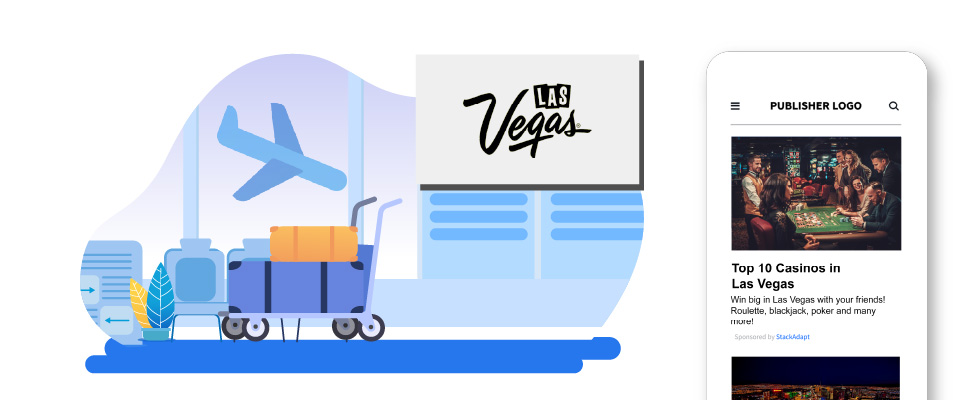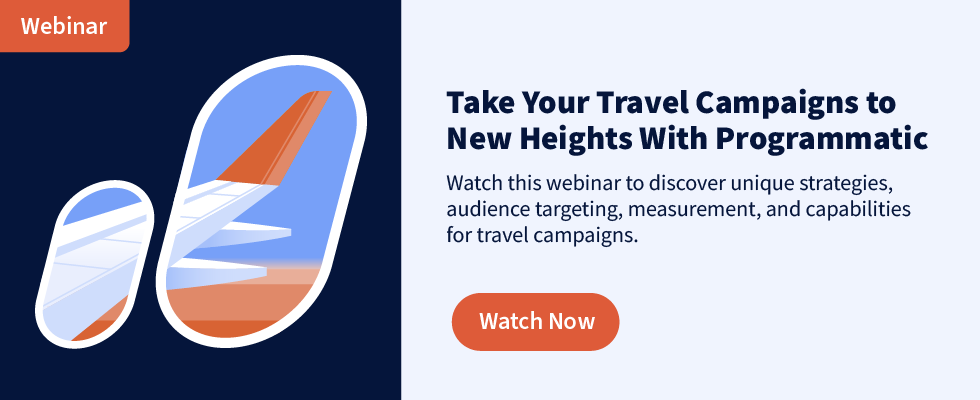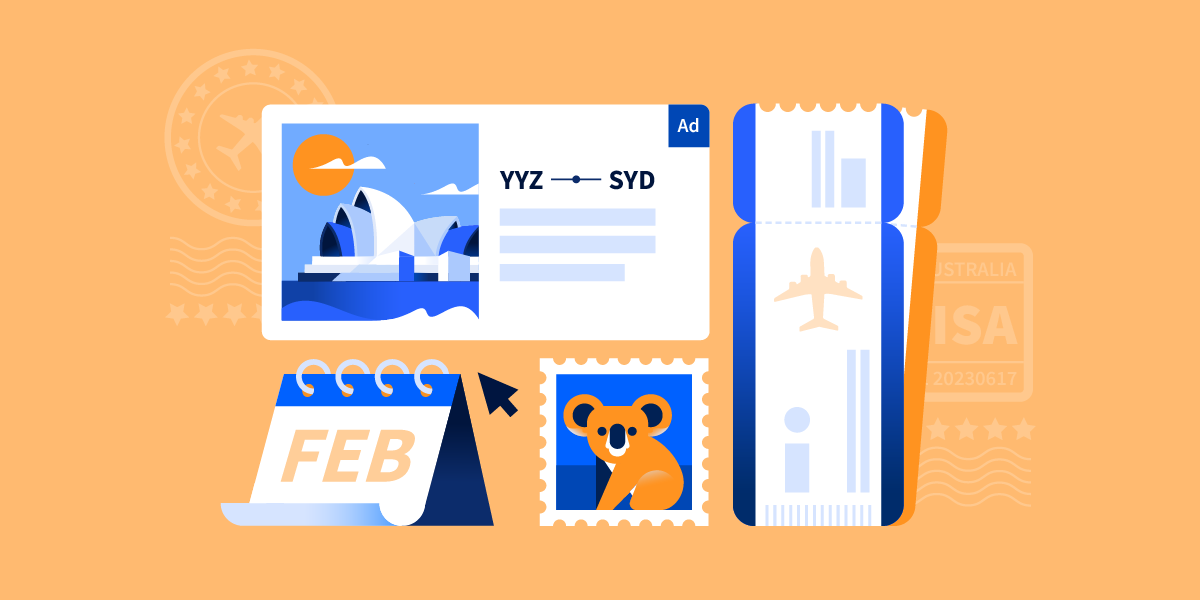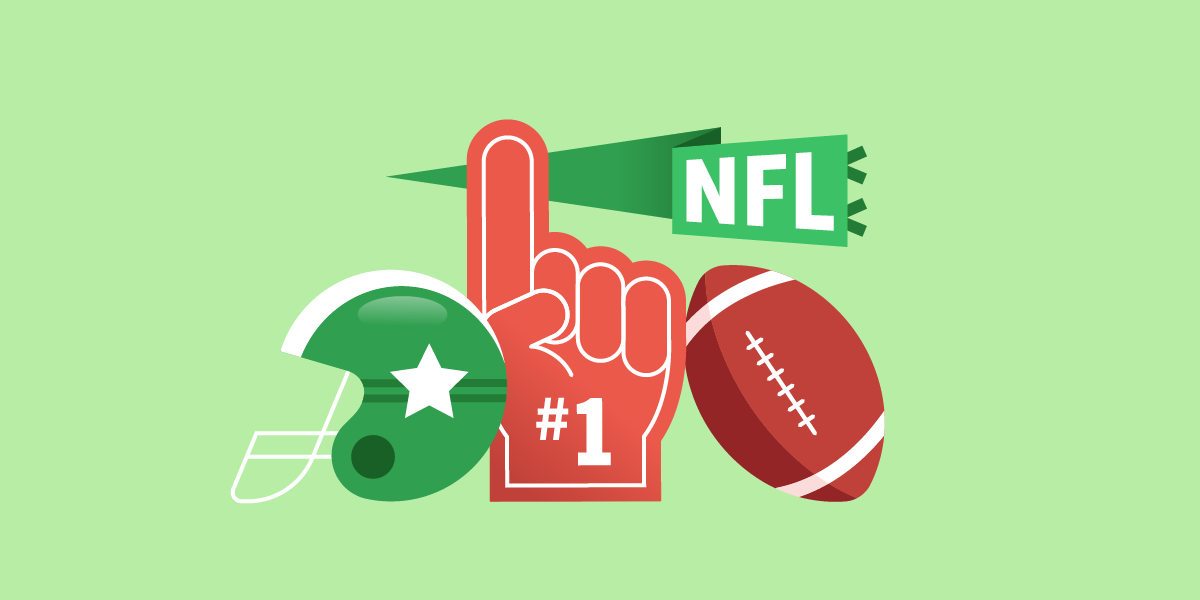The purchase path of today’s leisure traveller is becoming increasingly complex. Consumers have more options than ever before, creating a long and complicated purchase funnel. To engage today’s traveller, digital marketing for the travel industry needs to be dynamic and personalized.
Programmatic advertising channels offer many opportunities for digital marketers in the travel industry. Multi-channel campaigns make it possible to reach leisure travellers across their devices, and tactics like dynamic retargeting make it possible to personalize your messaging.
Read on to learn how you can drive the best results with digital marketing for the travel industry by leveraging the campaign targeting tactics and ad formats that appeal most to the travel audience.
5 Programmatic Targeting Tactics to Help You Fly High
Programmatic buying isn’t just efficient—it leads to more sophisticated and targeted campaigns.
Below is a list of 4 travel industry targeting tactics to help you reach the right audience.
1. Seasonal Targeting
Campaign timing is important because of the seasonal nature of travel bookings. Demand for travel services and offerings fluctuates based on events like festivals, weather, sports competitions, and school holidays. It’s also important to consider how far in advance travellers are booking their adventures.
A Virtuoso study found that travelers are, on average, booking trips farther ahead for 2023 than they did back in 2019. On the same line, an American Express Travel survey found that in the fall of 2022, 50% of American respondents were already thinking about where to go in summer 2023. With so many Americans thinking about their travel plans months in advance, catching their attention during this period is key.
Travel peaks also differ by location. For example, January to March is the peak season for enjoying the beaches in Mexico, while the US travel high season is June through August. Based on data from campaigns in StackAdapt, digital ad spend, site visits, and engagement are highest from May to June. This is likely because advertisers target travellers before and during the US summer high season, with June being the most popular month.
The second highest period for travel digital ad spend is September to November, which aligns with travellers planning their winter vacations to sunnier destinations.
Your campaign objectives will also impact timing. Your objective could be to advertise ahead of the peak season and take advantage of existing travel intent to increase sales. Or it could be to build awareness of off-season travel ideas, such as visiting a ski town in the summer at a more affordable rate.
If you want to stand out from the crowd, take advantage of opportunities when there is less advertising noise. This helps to amplify your message rather than subjecting your messaging to a media collision.
To determine seasonal campaign timing, look to industry and historical data to zero in on the times that have worked best (and worst). The benefit of programmatic advertising is that you can continually optimize to find the campaign timing that works for you, ensuring every ad dollar delivers the most value.
2. Travel Intent Targeting
Intent-based targeting is a more granular form of targeting that allows you to identify individuals showing interest in travel. Custom audience segments use machine learning to target individuals looking for flights, hotels, and activities based on the content they are consuming.
You can also identify individuals engaging with related content, such as a neighbouring city, content about a competitor’s brand, product reviews, or similar events. Leveraging intent-based targeting can help you optimize ad spend and drive more qualified traffic.
3. Route Targeting
Travellers engage when they see ads showing relevant routes to exciting destinations. Include creative messages that acknowledge their location or distance to reach your destination. In addition, when you know a potential traveller’s location, you can show an ad with the most convenient departure location to impact engagement and conversion rates.
For example, you can advertise flights to Las Vegas from two different locations, highlighting where the user is coming from. Both ads are for the same flight aggregator site, but the messaging and creatives are different based on geography.

4. Targeting With Private Marketplace Deals
Private marketplace (PMP) deals enable publishers to sell premium inventory directly to select buyers. After search and social, PMP deals are among the most popular ad choices for digital marketing for the travel industry.
Online travel agencies are highly-influential resources for travellers when making destination decisions. A PMP deal to have your ads appear on a bundling site, like Expedia, can help your brand connect with consumers as they start mapping out their trip.
Leverage your programmatic platform’s deal packages to capture vertical-specific inventory most suited to your brand or campaign. Whether your goal is to snag that above the fold placement or ensure an exact audience match with a curated list of travel publishers—PMPs can help you get there.
5. Dynamically Retargeting Leisure Travellers
Leveraging retargeting will deliver online ads to people based on their previous, intent-based actions on the web. This is an important tactic for re-engaging travellers who previously showed interest in your brand or products. By re-engaging them, you can move them down the funnel toward a conversion.
Dynamically retarget individuals with personalized native or display ad content based on the nature of their prior website engagement or activity. If someone has browsed through your travel offerings, continue to remind them of what they’re interested in throughout their online journey.
3 Channels to Use in Digital Marketing for the Travel Industry
Programmatic allows you to connect with travellers using a multi-channel approach that spans video, native, and display ad placements.
1. Bring Travel to Life with Video
Travel is an emotional experience, and so leveraging a programmatic channel that taps into that emotion is a great way to capture the interest of your target audience. Video is particularly effective for travel because it’s an engaging and immersive medium that uses visual cues to create emotion in viewers.
Video advertising can be used in digital marketing for the travel industry to engage viewers with storytelling and showcase the experiences available. By engaging a viewer’s emotion, a video might entice a consumer to book a weekend getaway at a hotel, or travel to a resort for the gorgeous beaches. When you run your video campaign on connected TV (CTV), it’s possible to capture and hold user attention particularly well because CTV provides a natural, full-screen experience.
Ads shown on CTV are highly viewable, and are served in an environment in which the audience is already engaged. When watching a connected TV device, viewers understand and accept that ads are part of the viewing experience. Knowing this, they are more receptive to them. These benefits combined with CTV’s enhanced-targeting options and inventory selection are just part of why we’re seeing CTV overtake linear ad spend.
2. Influence Travellers With Programmatic Audio
In 2022, 67% of Americans listened to digital audio, a 5% increase year-over-year. This growth is expected to continue as more people embrace digital audio. Programmatic audio automates the selling and insertion of ads into audio content. Ads reach your audience through various devices, including desktop, mobile, and tablet. You’re able to buy targeted ads from all the major audio publishers using one system.
In digital marketing for the travel industry, audio ads can be leveraged to inspire and influence listeners. Audio is an immersive and intimate medium that leverages storytelling to create a connection between the content and listeners. With an audio ad, you can inform audiences about a destination, hotel, or experience.
Data shows that compared to other media, digital audio is more likely to engage long-term memory for both details and memories, as well as increase emotional intensity. This results in a better receptiveness between the audience and a brand, which drives strong brand awareness.
3. Collect Data With Interactive Display Ads
An interactive display ad can help collect valuable data about your ideal customer. For example, you can use a discovery ad to ask the user what the weather is like where they are, encouraging them to interact with the ad they’ve seen. This helps to discover what type of vacation they might prefer.
Even if the viewer clicks all the weather options, you will be able to gauge interest in certain locations based on the conversion events. This example would be ideal to include in a retargeting campaign, once the target market is familiar with your brand.
With dynamic countdown ads, you can make sure your audience is aware of your travel sales and promotions, or you can leverage them to remind travellers that holiday breaks, like March Break, are coming up. A dynamic countdown unit will help create a sense of urgency for your audience to perform a specific action, like research or book an upcoming trip.
Digital Marketing for Travel Takes Off With Programmatic
Programmatic advertising is a highly-effective way to reach your target demographic throughout their travel-buying journey. Understanding the right targeting tactics and ad formats to leverage for your campaigns can help you attract more leisure travellers, and ultimately drive direct bookings.
Want to run exceptional programmatic travel campaigns? Request a demo to learn more about StackAdapt.






